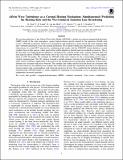| dc.contributor.author | Landi, E. | |
| dc.contributor.author | Holst, B. van der | |
| dc.contributor.author | Sokolov, I. V. | |
| dc.contributor.author | Gombosi, T. I. | |
| dc.contributor.author | Oran, Rona | |
| dc.date.accessioned | 2018-05-25T15:04:33Z | |
| dc.date.available | 2018-05-25T15:04:33Z | |
| dc.date.issued | 2017-08 | |
| dc.date.submitted | 2017-07 | |
| dc.identifier.issn | 1538-4357 | |
| dc.identifier.issn | 0004-637X | |
| dc.identifier.uri | http://hdl.handle.net/1721.1/115890 | |
| dc.description.abstract | We test the predictions of the Alfvén Wave Solar Model (AWSoM), a global wave-driven magnetohydrodynamic (MHD) model of the solar atmosphere, against high-resolution spectra emitted by the quiescent off-disk solar corona. AWSoM incorporates Alfvén wave propagation and dissipation in both closed and open magnetic field lines; turbulent dissipation is the only heating mechanism. We examine whether this mechanism is consistent with observations of coronal EUV emission by combining model results with the CHIANTI atomic database to create synthetic line-of-sight spectra, where spectral line widths depend on thermal and wave-related ion motions. This is the first time wave-induced line broadening is calculated from a global model with a realistic magnetic field. We used high-resolution SUMER observations above the solar west limb between 1.04 and 1.34 R o at the equator, taken in 1996 November. We obtained an AWSoM steady-state solution for the corresponding period using a synoptic magnetogram. The 3D solution revealed a pseudo-streamer structure transversing the SUMER line of sight, which contributes significantly to the emission; the modeled electron temperature and density in the pseudo-streamer are consistent with those observed. The synthetic line widths and the total line fluxes are consistent with the observations for five different ions. Further, line widths that include the contribution from the wave-induced ion motions improve the correspondence with observed spectra for all ions. We conclude that the turbulent dissipation assumed in the AWSoM model is a viable candidate for explaining coronal heating, as it is consistent with several independent measured quantities. | en_US |
| dc.description.sponsorship | National Science Foundation (U.S.) (Grant AGS-1322543) | en_US |
| dc.publisher | IOP Publishing | en_US |
| dc.relation.isversionof | http://dx.doi.org/10.3847/1538-4357/aa7fec | en_US |
| dc.rights | Article is made available in accordance with the publisher's policy and may be subject to US copyright law. Please refer to the publisher's site for terms of use. | en_US |
| dc.source | IOP Publishing | en_US |
| dc.title | Alfvén Wave Turbulence as a Coronal Heating Mechanism: Simultaneously Predicting the Heating Rate and the Wave-induced Emission Line Broadening | en_US |
| dc.type | Article | en_US |
| dc.identifier.citation | Oran, R. et al. “Alfvén Wave Turbulence as a Coronal Heating Mechanism: Simultaneously Predicting the Heating Rate and the Wave-Induced Emission Line Broadening.” The Astrophysical Journal 845, 2 (August 2017): 98 © 2017 The American Astronomical Society | en_US |
| dc.contributor.department | Massachusetts Institute of Technology. Department of Earth, Atmospheric, and Planetary Sciences | en_US |
| dc.contributor.mitauthor | Oran, Rona | |
| dc.relation.journal | The Astrophysical Journal | en_US |
| dc.eprint.version | Final published version | en_US |
| dc.type.uri | http://purl.org/eprint/type/JournalArticle | en_US |
| eprint.status | http://purl.org/eprint/status/PeerReviewed | en_US |
| dc.date.updated | 2018-05-25T13:50:30Z | |
| dspace.orderedauthors | Oran, R.; Landi, E.; Holst, B. van der; Sokolov, I. V.; Gombosi, T. I. | en_US |
| dspace.embargo.terms | N | en_US |
| dc.identifier.orcid | https://orcid.org/0000-0001-6419-552X | |
| mit.license | PUBLISHER_POLICY | en_US |
